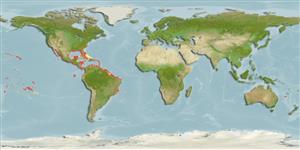Common names from other countries
Environment: milieu / climate zone / depth range / distribution range
Ecologie
marien; brak water rifbewoner. Tropical
Western Atlantic: Honduras to Santa Catarina, Brazil (Ref. 57756).
Lengte bij maturiteit / Grootte / Gewicht / Leeftijd
Maturity: Lm 7.0 range ? - ? cm
Max length : 22.6 cm TL mannelijk / geslacht onbekend; (Ref. 124486); common length : 14.0 cm TL mannelijk / geslacht onbekend; (Ref. 5217)
Dorsale stekels (totaal) : 0; Dorsale zachte stralen (totaal) : 8; Anale stekels: 0; Anale zachte stralen: 7. Upper two-thirds of head and body with groups of small dark brown spots; whitish ventrally; caudal fin with a dusky bar basally and a 2nd but fainter dark bar in outer middle part of fin (Ref. 13442).
Found over soft bottoms generally with vegetation such as Thalassia testudinum. Prefers turbid water (Ref. 9710). Feeds on marine invertebrates (Ref. 36453). Locally consumed but its visceral organs may be toxic.
Levenscyclus en paargedrag
Maturities | Voortplanting | Spawnings | Egg(s) | Fecundities | Larven
Cervigón, F., R. Cipriani, W. Fischer, L. Garibaldi, M. Hendrickx, A.J. Lemus, R. Márquez, J.M. Poutiers, G. Robaina and B. Rodriguez, 1992. Fichas FAO de identificación de especies para los fines de la pesca. Guía de campo de las especies comerciales marinas y de aquas salobres de la costa septentrional de Sur América. FAO, Rome. 513 p. Preparado con el financiamento de la Comisión de Comunidades Europeas y de NORAD. (Ref. 5217)
Status op de Rode Lijst van het IUCN (Ref. 130435)
CITES (Ref. 128078)
Not Evaluated
Gevaar voor de mens
Reports of ciguatera poisoning (Ref. 31174)
Gebruik door de mens
Visserij: commercieel
Tools
Speciale rapporten
Download XML
Internetbronnen
Estimates based on models
Preferred temperature (Ref.
115969): 23.5 - 28.4, mean 27.3 (based on 1083 cells).
Fylogenetische diversiteitsindex (Ref.
82804): PD
50 = 0.5000 [Uniqueness, from 0.5 = low to 2.0 = high].
Bayesian length-weight: a=0.01950 (0.01594 - 0.02386), b=2.90 (2.86 - 2.94), in cm Total Length, based on LWR estimates for this species (Ref.
93245).
Trofisch niveau (Ref.
69278): 3.5 ±0.37 se; based on food items.
Weerstandsvermogen (Ref.
120179): Hoog, minimale populatieverdubbelingstijd minder dan 15 maanden (Preliminary K or Fecundity.).
Fishing Vulnerability (Ref.
59153): Low vulnerability (13 of 100).
